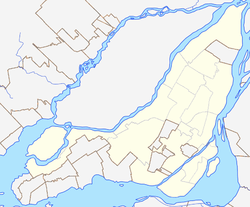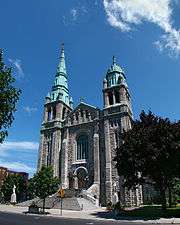Villeray, Montreal
| Villeray | |
|---|---|
| Neighbourhood | |
|
Bicycle path on Boyer Street in Villeray. | |
 Villeray Location of Villeray in Montreal | |
| Coordinates: 45°32′25″N 73°37′40″W / 45.540143°N 73.627882°WCoordinates: 45°32′25″N 73°37′40″W / 45.540143°N 73.627882°W | |
| Country | Canada |
| Province | Quebec |
| City | Montreal |
| Borough | Villeray-Saint-Michel-Parc-Extension |
Villeray is a neighbourhood in Montreal, Quebec, Canada. It is part of the Villeray–Saint-Michel–Parc-Extension borough and is situated in the north-central part of the Island of Montreal.
Origin of the name

The village of Villeray took its name from Louis Rouer de Villeray (1628-1700), who held various positions in the French regime. It became a town in 1896, before which the area had been farmland. When it was annexed to Montreal in 1905, its population was 800 (compared to 145,000 in the most recent census). At the time, Villeray was surrounded by quarries that provided material for the construction of many of the buildings in the area, as well as for several of the city's major landmarks. For some years, its inhabitants were chiefly stone workers, farmers and owners of small businesses.
Villeray is one of a few districts of Montreal where public transit predated full urbanization. Convenient public transit encouraged rapid urban development. One of the larger farms has remained a green space, becoming Jarry Park.
Geography
The territory of Villeray was well provided with streams and ponds and very amenable to cultivation. The original Jarry Farm covered 64 arpents (approximately 22 hectares, or 54 acres) and stretched as far north as the present-day Metropolitan (highway 40), south to Villeray St., east to St-Hubert and west to Foucher. The owner, one Stanislas Jarry, broke the land up into 680 lots at the beginning of the 20th century. Other members of his family owned land in what would eventually be called Villeray–Saint-Michel–Parc-Extension.
Presently the district of Villeray is enclosed between Avenue Casgrain in the west, Boulevard Jean-Talon in the south, Rue Garnier in de east and the Metropolitan (highway 40) to the north.[1] These borders were determined in the creation of the borough of Villeray–Saint-Michel–Parc-Extension, which was created on January 1, 2002, following the municipal reorganization of Montreal.
A burst of development at the beginning of the 20th century
Originally Villeray's houses were wooden ones, typically owned by workers, with sheds and stables in back. From 1915 to 1930, Villeray saw a boom which brought with it the need for schools, churches, a public bath and a fire station, built at the corner of Jarry and St-Hubert in 1912.
Construction of the first public bath
The imposing Montreal Institute for the Deaf, with a façade made of Montreal stone, was built near Faillon and de Castelnau during World War I by the Clercs de Saint-Viateur. The arrival of this additional population created certain health issues, as regular bathing was not so common then. A public bath, the bain St-Denis, was built on St-Hubert St. in 1909-1910 but this was not sufficient: typhoid, tuberculosis and smallpox were endemic in the area, leading to a level of infant mortality much higher than in other parts of Montreal.
Post World War II
After World War II the typical Montreal duplex and triplex became the standard domestic architecture in Villeray, and the town filled up with rows of these buildings, whose spiral front staircases, back alleys, clotheslines and sheds are well-known features of residential Montreal.
Raoul Jarry
Raoul Jarry, Montreal city councillor from 1921 and member of its executive committee from 1924, saw in Jarry Park a means of offering some open green space to fight the diseases that spread among children in summertime and to encourage them to participate in sports and families to picnic and relax together. It was due to his efforts that the city purchased this land, which had up till then been leased from the corporation of its original owner, Stanley Clark Bagg (memorialized by Bagg Street further south in Plateau Mont-Royal). Raoul Jarry died in 1930 and the park is named after him (whereas Jarry Street is named after Bernard Bleignier dit Jarry, an 18th-century landlord).